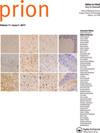2023 年朊病毒会议:不断发展的领域的影响
IF 1.9
3区 生物学
Q4 BIOCHEMISTRY & MOLECULAR BIOLOGY
引用次数: 0
摘要
摘要 人类朊病毒疾病的历史始于汉斯-格哈德-克雅氏病(Hans Gerhard Creutzfeldt)和阿方斯-玛利亚-雅各布(Alfons Maria Jakob)对严重脑部疾病患者的最初描述,这些患者患有言语异常、精神错乱和肌阵挛等疾病,这种疾病当时被命名为克雅氏病(CJD)。后来,在巴布亚新几内亚发现了一种以颤抖为特征的疾病,并命名为 "库鲁"。对 CJD 和 Kuru 患者的大脑以及患有绵羊瘙痒症的绵羊大脑进行的神经病理学检查发现,这两种疾病具有显著的相似性,并表明可能存在一种共同的感染模式,当时人们认为这种模式源自一种可导致缓慢感染的未知病毒。约翰-斯坦利-格里菲斯(John Stanley Griffith)假设,导致这些疾病的病原体 "很可能是一种不含核酸的蛋白质"。1982 年,斯坦利-普鲁西纳(Stanley Prusiner)报告说,他发现了一种对当时核酸标准灭活方法具有抵抗力的蛋白型传染性颗粒(创造了朊病毒一词),并确定 PrP 为瘙痒病和克雅氏病中传染性病原体的主要蛋白质成分,将其也归类为朊病毒疾病。有趣的是,朊病毒的概念以前曾扩展到酵母蛋白质,它们能够复制自己的构象、播种自己的聚集体并传递表型信息。最近,朊病毒的概念被扩展为能够将正常形式的蛋白质转化为异常形式的错误折叠蛋白质。为了解和治疗朊病毒疾病,一个特定的研究团体围绕这一主题团结起来,多年来定期举行会议(朊病毒会议),以促进讨论、培训初级研究人员并激励该领域的研究。本文章由计算机程序翻译,如有差异,请以英文原文为准。
Prion meeting 2023: implications of a growing field
ABSTRACT The history of human prion diseases began with the original description, by Hans Gerhard Creutzfeldt and by Alfons Maria Jakob, of patients with a severe brain disease that included speech abnormalities, confusion, and myoclonus, in a disease that was then named Creutzfeldt Jakob disease (CJD). Later, in Papua New Guinea, a disease characterized by trembling was identified, and given the name “Kuru”. Neuropathological examination of the brains from CJD and Kuru patients, and of brains of sheep with scrapie disease revealed significant similarities and suggested a possible common mode of infection that, at the time, was thought to derive from an unknown virus that caused slow infections. John Stanley Griffith hypothesized that the agent causing these diseases was “probably a protein without nucleic acid” and, in 1982, Stanley Prusiner reported the identification of a proteinaceous infectious particle (coining the term prion) that was resistant to inactivation methods that were at the time standard for nucleic acids, and identified PrP as the major protein component of the infectious agent in scrapie and in Creutzfeldt-Jakob disease, classifying this also as a prion disease. Interestingly, the prion concept had been previously expanded to yeast proteins capable of replicating their conformation, seeding their own aggregation and transmitting phenotypic information. The prion concept has been more recently expanded to refer to misfolded proteins that are capable of converting a normal form of a protein into an abnormal form. The quest to understand and treat prion diseases has united a specific research community around the topic, and regular meetings (Prion Meetings) have taken place over the years to enable discussions, train junior researchers, and inspire research in the field.
求助全文
通过发布文献求助,成功后即可免费获取论文全文。
去求助
来源期刊

Prion
生物-生化与分子生物学
CiteScore
5.20
自引率
4.30%
发文量
13
审稿时长
6-12 weeks
期刊介绍:
Prion is the first international peer-reviewed open access journal to focus exclusively on protein folding and misfolding, protein assembly disorders, protein-based and structural inheritance. The goal is to foster communication and rapid exchange of information through timely publication of important results using traditional as well as electronic formats. The overriding criteria for publication in Prion are originality, scientific merit and general interest.
 求助内容:
求助内容: 应助结果提醒方式:
应助结果提醒方式:


